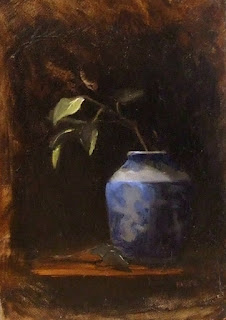
 Here are two small still lifes. I'm using them as an example of a principle about light and shadow and background color.
Here are two small still lifes. I'm using them as an example of a principle about light and shadow and background color.In a still life, one of the important things to consider is the background. The background doesn't just represent the "back" of whatever space you are painting.
It is , or should be, representative of the air and the atmosphere surrounding the focal points. Your objects need to exist in space.
By the way, while I'm thinking of it, consider giving your still life objects MORE space than you might initially be inclined. One of the common traits of beginning artists is to paint that pot, or the apple, or whatever as large as they can fit on the canvas. Let them breathe! Give them some room! Up front and in your face can be a valid compositional decision, but if you will take time to study some of the great paintings, you will notice that there is some comfortable distance between the viewer and the objects portrayed. Try it!
Background color can be light or dark, it can be generally warm or cool. These two paintings are examples of a darker, warm background, and a lighter, cooler background. Background color is an aesthetic decision that you will make as you arrange the still life in the first place.
However, having decided on your set up and the background color, you have also determined, in part, the form shadow color of your objects.
How does that work?
Since the background is at least in part the "air" around your objects, as the form of those things recede into space they have a little bit more of that air or atmosphere between them and you, the viewer. When you are trying to "make that pot look round" what you are actually doing is trying to show how the form turns back and goes further into space. One way to help create this illusion is to include a little bit of the background color into those form edges. Take for example, the leaf that is in the first still life, that is on the right side of the stem. It is further back in space than the more brightly lit leaf, and you can see how it has much more of the background color floated into it. You can also see this in the shadow side of the pot... there is a bit of that background in there, and the effect is that the pot is round, and the edge turns back into space.
In the other still life, the background color is lighter and cooler, but the principle still works.
Look at the lemon slice in the background. Compare the color of that lemon to the foreground slice. Can you see that the further lemon slice contains some of that cooler greenish gray background color? If you have trouble seeing it, try squinting. Squinting is a great way to reduce superfluous detail while you are painting, and renders the major values more clearly.
There is an important principle to remember, and that is this:
COOL LIGHT/ WARM SHADOW.
The overall shadow color in a still life should always be warm!
Unless you're painting objects on a sunny windowsill, then you should consider that the light represents cooler, natural north light. This means shadows will be warm. So, if you have a cooler background color, as in the second example here, it is only a touch added to the native color of your object, or mixed into your overall shadow color. Don't make the mistake of thinking that you can just take your background color and use that as shadow color. This is where the intelligence and keen observation of the artist must come into play. Look at the whole lemon - can you see how the overall shadow color is very warm, an orangey-green, and the reflected light from the table top is even warmer, but right at the top edge of the shadow form, there is a bit more of that background greenish gray color. There's no reflected light there, and no direct light, so the background color has a bit more influence.
Well, this is alot to think about, and there are no quick fixes or "systems". There is only the intelligence and observation of you, the artist, making decisions which best further the concept and design of your painting. If it were easy, anybody could do it, right?
Deb, I am working on a still life right now where I am confused about handling the background color. Also I'm going to check back at my last few still lifes using your details- thanks for the great clarification!
ReplyDelete